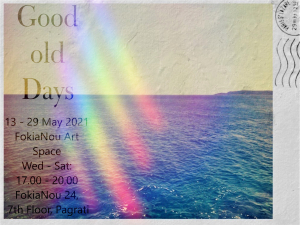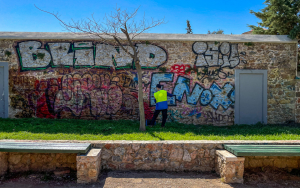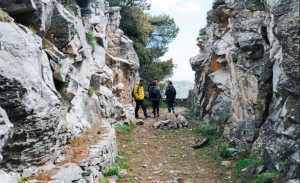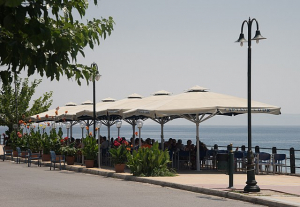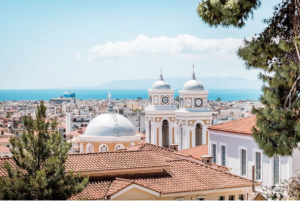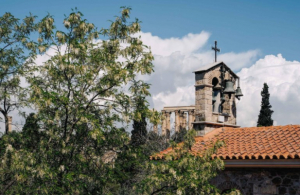LIFE & CULTURE
XpatAthens
Monday, 10 May 2021 13:11
FokiaNou Art Space - Good Old Days
After seven months of lockdown, FokiaNou Art Space is pleased to present a group exhibition of artists focusing on the idea of past times, i.e. pre-Covid, pre-crisis, when we all had different things on our minds. The show is a diverse kaleidoscope of works, including painting, drawing, collage, photography, video and sculpture, which while looking back, also speaks for today’s state of mind and looks forward to better times as well.
Participating artists: Lina Bebi, Sebastian Boulter, John Bicknell, Mary Cox, Irini Diadou, Sarah Ettlinger, Panagiotis Ferentinos, Christos Giannopoulos, Andromachi Giannopoulou, Chris Hawtin, Marietta Kallona, Vassiliki Kanellou, Alexandros Mavrogiannis, Foteini Poulia, Caroline Pradal, Marina Rovithi, Evi Stamou, Iliana Theodoropoulou, Panagiotis Voulgaris, Alexandros Zoulias.
Curated by Mary Cox and Panagiotis Voulgaris.
The use of masks and social distancing are required in all areas of the space, including the roof terrace, halls and elevator.
Published in
Art
Tagged under
Sunday, 09 May 2021 18:27
Athens’ Anti-Graffiti Initiative Cleans Up Ermou Street
As part of its anti-graffiti campaign, the Municipality of Athens took on the initiative of delivering Ermou street back to the public free of paints and slogans.
This big operation was conducted by the municipality's cleaning units, under the coordination of Deputy Mayor for Cleaning and Recycling, Nikos Avramidis. The specialized crews worked for more than 18 days in order to overturn the image of abandonment in an area brimming with important archaeological findings.
After years of aesthetic vandalism, the stone-built wall of 2,300 m2, located at the archaeological site of Kerameikos, is now, once again, sparkling clean. Six hundred liters of solvent and 88 tons of water were used in order to remove years of graffiti, while the specialized crews used 200 liters of special liquid to ensure the wall's protection against future vandalism. At the same time, graffiti of aesthetic and artistic value was protected with special coverings, which act as a deterrent against any type of vandalism.
XpatAthens extends a warm thank you to This Is Athens and the City Of Athens for sharing news and inspiring stories about how Athens aspires to be a clean, friendly, and welcoming city to live in.
XpatAthens extends a warm thank you to This Is Athens and the City Of Athens for sharing news and inspiring stories about how Athens aspires to be a clean, friendly, and welcoming city to live in.
Published in
Local News
Tagged under
Sunday, 09 May 2021 15:19
What Helps Me Deal With My Daughter’s Anger - A Valuable Tool During Quarantine
My eight-year-old daughter is so fed up and tired from online schooling. It’s been going on for a long time now. No kids to play, no socializing, pressure to follow the classes in front of the screen. The same screen we try to put a limit to and tell her to avoid. Double messages, mixed feelings, lots of pressure, lots of anger hence the aggressive behavior.
My husband and I both work from home and we often have to share our home office. We are also tired. We feel the pressure too although we try different ways to cope and recharge. Three people in the house all the time – I can only imagine how it may be with more. It’s very easy to pick up on each other’s stress and mirror it. It’s very easy to let difficult situations escalate to volcano reactions.
The general advice, that I’m sure you’ve heard, is to keep everyday life as stable as before COVID and maintain a routine; as much as possible that is. Because truth is that nothing is the same. In fact, some things have changed so much so that it’s possible they won’t go back to the way they were.
What helps me deal with my daughter’s anger and put things into perspective, especially now during the COVID quarantine, is to try to think of the possible factors that may create it:
- Her specific needs that have not been met.
- Non-realistic expectations – hers and ours.
- The sense that she’s been wronged.
- The sense of not having enough control and choices over her life.
- Her fear of losing someone dear due to the pandemic.
- Physical pain.
- Unfulfilled goals.
- Punishment, conflicts.
Originally Published on: itsmylife.gr
Written by Nadia Georgiou
If there’s a topic you’re interested in and would like to learn more about you may contact me via email. For more information about me and my work check the XpatAthens Directory or visit my website. Because this is your life!
Published in
Parenting
Tagged under
Thursday, 06 May 2021 14:00
Marble Marvels: A Historic Hike on Mount Penteli
Mount Penteli is one of the four ranges that cradle Athens and at 1,006 metres, is the second highest summit after Mount Parnitha.
The mountain is world-famous for its marble which has long been prized for its purity. The marble quarries there operated from around the 6th century B.C. until the 1940s and yielded the vast bulk of the material used to build the Acropolis and the ancient city of Athens.
We’re headed for the Dionysos open-air marble museum, a reconstruction complete with crumbling miner’s shacks, tool sheds, and dramatic scree mounds, to drive home this mountain’s mighty marble legacy.
During the four hours or so we are up here, we encounter totally different landscapes; from gorgeous open panoramas and austere quarries to woodland meadows carpeted with wildflowers (and rare butterflies). There’s also a delightful trio of storybook chapels the size of Wendy houses, decorated with holy icons, and springwater taps where we top up our bottles with sweet mountain water.
It’s also about what we don’t see. As in other people. Barring a few faded red markings on rocks, Penteli is not a sign-posted route. It helps keep the crowds at bay.
After about 45 minutes, we emerge into a natural clearing backed by an imposing wall of multi-coloured marble rock. This is the climbing section of Penteli. Known as Dionysos, it’s among the most popular in Attica (wider Athens) and one of the few places in Greece where you can pit yourself against sheer marble precipices around 15-20m high.
We’re now standing at the mouth of a steep ramp-like track scattered with marble shrapnel. The path plunges like a black ski-run towards the lush foothills below. This is the platform they used to send marble blocks the size of a car down the mountain. They’d tie them up with cables; then release them slowly on ropes.
I try (and fail) to visualise the Herculean Endeavour of shifting all those mammoth marble bricks from here to the Parthenon building site, some 25 kilometres away.
Next, we stop near the stony reconstruction of what looks like an open-air “staff canteen” built into the sloping quarry, adjacent to the old tool construction area. That’s where they would place the dynamite to break up the rock in modern times. In ancient Greece, they soaked flints in water and stuck them into holes where they would expand and break up the marble.
Many of Penteli’s quarry workers hailed from Paros island. The Parians were good workers, apparently, and had a knack with marble (the legendary Venus de Milo was sculpted from Paros marble).
The Dionysos marble museum isn’t really a museum in the strictest sense. There are no maps or organised exhibits. It’s more of an atmospheric theatre set, built atop the retired ancient quarry to represent everyday working life.
We continue up the steady incline; marble debris clinking musically underfoot, like pebbles knocking together on a shore.
To read this article in full, please visit: thisisathens.org
Next, we stop near the stony reconstruction of what looks like an open-air “staff canteen” built into the sloping quarry, adjacent to the old tool construction area. That’s where they would place the dynamite to break up the rock in modern times. In ancient Greece, they soaked flints in water and stuck them into holes where they would expand and break up the marble.
Many of Penteli’s quarry workers hailed from Paros island. The Parians were good workers, apparently, and had a knack with marble (the legendary Venus de Milo was sculpted from Paros marble).
The Dionysos marble museum isn’t really a museum in the strictest sense. There are no maps or organised exhibits. It’s more of an atmospheric theatre set, built atop the retired ancient quarry to represent everyday working life.
We continue up the steady incline; marble debris clinking musically underfoot, like pebbles knocking together on a shore.
To read this article in full, please visit: thisisathens.org
Photo by: Thomas Gravanis
Thank you This is Athens for your contribution as an XpatAthens Partner.
Whether you've just arrived in town – or have been here for years – Athens always has new secrets to share!
This is Athens is the official guide to this captivating city of ancient energies and booming urban culture. Compiled by a team of specialist local writers, This is Athens brings you an authentic and intimate portrait of a living Athens beyond the guidebooks – along with daily curated listings of all the best events and great weekend inspiration all-year round. From must-know neighbourhoods and emerging art hubs, to gourmet hotspots, cool shopping and the buzziest bars, This is Athens will help you to get the most out of living in Athens!
Thank you This is Athens for your contribution as an XpatAthens Partner.
Published in
City Discovery
Tagged under
Thursday, 06 May 2021 13:42
Greek Doctor Uses AI To Improve Life Of Cancer Patients
Dr. Peter Metrakos is the Greek leader of a research team that uses breakthrough artificial intelligence (AI) technology to improve the survival rates of cancer patients.
Based in Canada, the team of physicians are working to help patients with colorectal cancer survive this shockingly deadly disease, which currently has a five-year survival rate of just 12%.
The research team is working with the Research Institute of the McGill University Health Centre (RI-MUHC) to develop personalized medicine in the colorectal cancer field and the whole project is based on Metrakos’ 2016 research into colorectal cancer cells’ relationship to blood vessels.
The Greek doctor and his team will use liquid biopsy methods to isolate the constituent sections of a cancer patient's blood in order to figure out which ones are linked to the disease. This information will be given anonymously to MIM, a Montreal-based AI company, which will attempt to identify patterns in patients' blood.
Using the data obtained through AI, researchers should be able to create customized treatment plans for patients who would otherwise not respond to conventional therapies.
To read this article in full, please visit: greekreporter.com
Published in
Greece In The News
Tagged under
Tuesday, 04 May 2021 14:32
Small Ways We Can Protect The Environment
There are so many small steps we can take to help protect the environment from using metal straws instead of plastic ones to reducing food waste by eating leftovers and making use of the vegetables in the fridge before they go bad.
Here are a few eco-friendly habits that do their part in protecting the environment on a regular basis. Which of these strategies will you try?
Turn off the lights when you leave the room
Marta from France recommends: “Ever since I was little, I was told to turn the lights off when I left a room. I’ve continued that habit into adulthood and have passed it on to my kids. There’s no need to keep the light on in an empty room, and every small green gesture helps.”
Bring your own bags to the grocery store
Kaleana from California recommends: “Since the pandemic began, our local grocery stores were forced to ban reusable bags. This has resulted in the excessive use of plastic bags for each grocery run. To help mitigate this, I began to request that the grocery clerk simply reload my groceries into the cart at checkout. Then, I would transfer the items into the reusable bags in the trunk of my car from the parking lot. This has allowed me to follow COVID protocols while reducing my carbon footprint!
Kaleana from California recommends: “Since the pandemic began, our local grocery stores were forced to ban reusable bags. This has resulted in the excessive use of plastic bags for each grocery run. To help mitigate this, I began to request that the grocery clerk simply reload my groceries into the cart at checkout. Then, I would transfer the items into the reusable bags in the trunk of my car from the parking lot. This has allowed me to follow COVID protocols while reducing my carbon footprint!
Swap out your paper towels for cloth
Nikki from Illinois recommends: “In an effort to leave a better world for my grandchildren, I started using cloth napkins and cotton towels instead of paper napkins and towels. Sadly, paper towel production not only destroys a large number of trees but also uses a lot of water. Not to mention, a lot of our paper products end up in landfills. I’ve also started using wool dryer balls versus the dryer sheets which are single-use and loaded with chemicals. I’m taking an inch-by-inch approach as I work to be a better steward of our planet.”
Nikki from Illinois recommends: “In an effort to leave a better world for my grandchildren, I started using cloth napkins and cotton towels instead of paper napkins and towels. Sadly, paper towel production not only destroys a large number of trees but also uses a lot of water. Not to mention, a lot of our paper products end up in landfills. I’ve also started using wool dryer balls versus the dryer sheets which are single-use and loaded with chemicals. I’m taking an inch-by-inch approach as I work to be a better steward of our planet.”
Start using a metal water bottle
Isabelle from California recommends: “I do not use plastic bottles anymore, and I’m making an effort to use only metal bottles that I refill when I am on the go. I also help a local organization, Child Creativity Lab, build STEAM kits for kid programs with recyclable materials and we encourage the local community and businesses to recycle materials going to trash by dropping them off at our lab.”
To read this article in full please visit: thriveglobal.com
Isabelle from California recommends: “I do not use plastic bottles anymore, and I’m making an effort to use only metal bottles that I refill when I am on the go. I also help a local organization, Child Creativity Lab, build STEAM kits for kid programs with recyclable materials and we encourage the local community and businesses to recycle materials going to trash by dropping them off at our lab.”
To read this article in full please visit: thriveglobal.com
Published in
Planet
Tagged under
Tuesday, 04 May 2021 14:07
Cafes & Restaurants Reopen In Greece For Outdoor Service
Cafes and restaurants reopened in Greece on Monday for sit-down service for the first time in nearly six months, as the country began easing coronavirus-related restrictions with a view to opening to the vital tourism industry in the summer.
Cafes, restaurants, and bars, which had been shut to all but takeout and delivery services when lockdown-type measures were imposed in early November, reopened for outdoor seated service only. Tables are set a certain distance apart to maintain social distancing while standing customers and music aren’t allowed.
A maximum of six customers are allowed per table, while staff must carry out compulsory coronavirus home self-tests. A nightly curfew that was in force from 9 p.m. is being pushed back to 11 p.m. as of Monday, with bars, restaurants, and cafes allowed to remain open until 15 minutes before curfew.
In recent weeks, the Greek government has been gradually easing restrictions as part of the efforts being made to lay the groundwork for Greece to welcome back tourists. Tourism is a vital industry for the country, and all tourism-related businesses and services are scheduled to reopen on May 15.
To read this article in full please visit: ekathimerini.com
To read this article in full please visit: ekathimerini.com
Published in
Local News
Tagged under
Thursday, 29 April 2021 14:08
It's Easter In Greece
With Easter upon us, what a better way to celebrate it in Greece than with some great tips about the festive local traditions, recipies and a guide to some of the most beautiful churces in Athens. Learn all about them in this week's newsletter!
Please click HERE to view this issue of our newsletter!
Published in
Newsletters
Tagged under
Monday, 26 April 2021 22:44
Some Of The Most Beautiful Churches In Athens
Before Greece won its independence in 1829, some 130 churches were recorded in Athens. Ironically, many were destroyed not by the Ottomans, but during the construction of the modern Greek capital. Churches were often used as a source of building material, much as the ancient temples had been used earlier. You’ll often see sections of columns integrated into the altar or walls.
Orthodox tradition often absorbs the pagan practices of antiquity too. So don't be surprised if you find far-from-saintly figures like Heracles or Hebe, the gods’ cupbearer and goddess of eternal youth, on the frieze of a 9th-century church. Here's a roundup of the most stunning churches in Athens!
Note from XpatAthens
Note from XpatAthens
If you're celebrating Easter in Greece in 2021 please be sure to read about coronavirus restrictions.
Agia Dynami
Agia Dynami
Location: 15 Mitropoleos & Pendelis, Historic Centre
This 16th-century church has a history as big as its size is small. It was linked by an underground tunnel to a small gunpowder plant that supplied the Ottoman troops. When the independence revolt erupted, the munitions maker smuggled some of the gunpowder to the Greeks through the tunnel. Aside from its odd location in the belly of the former Ministry of Education (now the Electra Metropolis hotel), another unusual feature is the church’s tiny, crenellated windows
Agia Fotini
Location: 3 Ardittou, Pangrati
Location: 3 Ardittou, Pangrati
Fotini was a Samaritan prostitute who achieved sainthood by offering Christ a cup of water. This simple basilica in her honor preserves some of the original murals of the fourth-century church, which was reconstructed in the 1870s. Archaeological evidence suggests there were sanctuaries to Hekate and Pan on the site. Next to the steps leading to the church is the only preserved section of an arched bridge over the Ilissos River, constructed in 1850 on orders of Greece’s first king
Agia Irini
Location: 36 Aiolou & Athinaidos, Historic Centre
Location: 36 Aiolou & Athinaidos, Historic Centre
Built in 1847, using material from destroyed churches as well as the Acropolis, this massive church was intended to serve as the Metropolitan Cathedral. It was the site for many official events such as Othon’s coming of age, groundbreaking for the new palace, and services marking the first anniversary of the constitution. Marble columns support a balcony and deep recesses are decorated with religious scenes, including St Paul preaching to the Athenians.
To read this article in full and discover more beautiful churches please visit: thisisathens.org
Photo by: Georgios Makkas
Thank you This is Athens for your contribution as an XpatAthens Partner.
Whether you've just arrived in town – or have been here for years – Athens always has new secrets to share!
This is Athens is the official guide to this captivating city of ancient energies and booming urban culture. Compiled by a team of specialist local writers, This is Athens brings you an authentic and intimate portrait of a living Athens beyond the guidebooks – along with daily curated listings of all the best events and great weekend inspiration all-year round. From must-know neighbourhoods and emerging art hubs, to gourmet hotspots, cool shopping and the buzziest bars, This is Athens will help you to get the most out of living in Athens!
Thank you This is Athens for your contribution as an XpatAthens Partner.
Published in
City Discovery
Tagged under
Friday, 18 June 2021 07:28
Greek Modern Art - Yannis Moralis
Do you like modern and contemporary art? Then for sure, Athens, featuring numerous galleries and fabulous museums where you can enjoy modern art, is the place to be!
Greece might be known for its ancient Greek culture, statues, ceramics, and temples, but is also a country where you can see a lot of modern art and contemporary architecture, as well as visit museums covering the living artists or those numerous famous Greek names and talented artists of the 20th century. With that said, let’s introduce you to a very known Greek painter and one of Greece’s leading 20th-century artists, Yιannis Moralis, whose paintings can be found in public and private collections in Greece, as well as abroad.
Who Was Yιannis Moralis?
Ηe was born in the town of Arta in 1916, but lived in Preveza from 1922-1927, due to the fact that his father served as Principal at High School of Preveza. He moved to Athens with his parents in 1927. From the age of 15, he studied at the Athens School of Fine Arts, from where he graduated in 1936. The following year he won a scholarship from the Athens Academy and left for Rome.
Ηe was born in the town of Arta in 1916, but lived in Preveza from 1922-1927, due to the fact that his father served as Principal at High School of Preveza. He moved to Athens with his parents in 1927. From the age of 15, he studied at the Athens School of Fine Arts, from where he graduated in 1936. The following year he won a scholarship from the Athens Academy and left for Rome.
Moralis would stay in Italy until November 1937 and then moved to Paris where he studied at École Nationale des Beaux-Arts. At the same time, he registered in École des Arts et Metiers, to master mosaic. With the declaration of World War II, however, he returned to Greece hurriedly.
In 1940 he exhibited a series of engravings with the group “Free Artists” in Piraeus. In the same year, he assigned to the army and served his term while participating in the last pre-war Pan-Hellenic Exhibition in Zappeion, where he also received the bronze medal.
In 1954, he began his collaboration with the Theater of Art of Karolos Koun, and later on, he also collaborated with the National Theater. In 1958, together with Yiannis Tsarouchis and sculptor Antonis Soutsos, he represented Greece at the Venice Biennale.
If you want to learn more facts about Yannis Moralis and see pictures from his solo exhibit in the Benaki Museum please visit: masaresi.com

About MASARESI
Masaresi.com was founded by Maya Cornelissens-Andreadi, who shares her experience about how “to integrate in Greece and feel like a local”. Masaresi = μας αρέσει = we like it! Discover the “real Greece," while delving into all the aspects of Greek life – from modern lifestyle and culture to history, literature, traditions, and many more.
Explore Greece - Read About Greece - Buy Greek - Learn Greek
Published in
Greek Language & Culture
Tagged under

